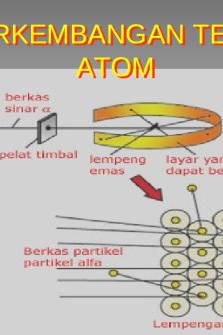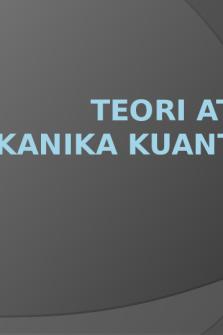PhET Build an Atom PDF

| Title | PhET Build an Atom |
|---|---|
| Author | Genevieve Kuhn |
| Course | Introductory Chemistry |
| Institution | Diablo Valley College |
| Pages | 4 |
| File Size | 209.1 KB |
| File Type | |
| Total Downloads | 78 |
| Total Views | 129 |
Summary
Chapter 2...
Description
BUILD AN ATOM PART I: ATOM SCREEN Build an Atom simulation https://phet.colorado.edu/en/simulation/build-an-atom 1. 2.
Explore the Build an Atom simulation. a) List two things you observed in the simulation. -
electrons are around the neutrons and protons the neutrons and protons are messily together, there isn’t any order
b) What particle(s) are found in the center of the atom? neutrons and protons 3.
Play until you discover which particle(s) determine(s) the name of the element you build. What did you discover? protons determine the element
4.
What is the name of the element that has the following number of subatomic particles? Example: An atom with 6 protons and 6 neutrons: Carbon a) An atom with 3 protons and 4 neutrons: ___Lithium___ b) An atom with 2 protons and 4 neutrons: ___Helium___ c) An atom with 4 protons and 4 neutrons: ___Beryllium___
5.
Play with the simulation to discover which particles affect the charge of an atom or ion. protons and electrons. a) Fill in the blanks below to show your results: Neutral atoms have
the same number of
protons and electrons.
Positive ions have _____more_____ protons than electrons. Negative ions have _____less_____ protons than electrons. b) Develop a relationship (in the form of a single sentence or equation) that can predict the charge based on the number and types of particle. If there are more electrons than there are protons then the charge is negative and if there are less electrons than protons than the charge is positive. The difference of the electrons(E) from the protons(P), P-E= charge 6.
Play with the simulation to discover what affects the mass number of your atom or ion. protons and neutrons. a) What is a rule for determining the mass number of an atom or ion? The total number of protons and neutrons in the nucleus is the mass number.
BUILD AN ATOM
1 of 3
7.
Practice applying your understanding by playing 1st and 2nd game on the game screen.
PART II: SYMBOL SCREEN 8.
Using the Symbol readout box, figure out which particles affect each component of the atomic symbol. a) In the atomic symbol to the right, label each letter (a, b, c, and d) with: ● the particle(s) used to determine the letter, and ● how the value of each letter is determined. a = protons, element, the number of protons determines the identity b = electrons and protons, the charge, the difference of protons and electrons, protons-electrons= b c = number of protons, atomic number d = the total of the protons and neutron, mass number
9.
Create a definition (using a complete sentence) for each of these items based on your labels from the atomic symbol above. a) Element Symbol- abbreviation of the element name which is determined by the number of protons. b) Charge- the difference of the total number of electrons from the total number of protons. c) Atomic Number- the total number of protons which determines the identity of the element. d) Mass Number- the total number of protons and neutrons added together.
10. Practice applying your understanding by playing the 3rd and 4th game levels. Play until you can get all the questions correct on the 4th level. 11. In addition to atomic symbols, we can represent atoms by name and mass number. a) Complete the table below: Symbol
Name Carbon-12 Fluorine-18 Boron-11
2 BUILD AN ATOM
b) Each representation (Symbol and Name) in the table above provides information about the atom. Describe the similarities and differences between the Symbol and Name representations. With both the symbol and name we can determine other information on the atom, like the number of neutrons and such. With the name we do not have the atomic number but because we know the atomic number determines the identity and we have the identity, we can find out the number of protons, but it is just not written out on the name representation. The symbol shows the atomic number and mass number as well as the element abbreviation. The differences are that the name doesn’t list the atomic number but has the written out element name whereas the symbol has the atomic number and abbreviation. both the symbol and name have the mass number.
PART III: ISOTOPES 12. Play with the atom simulation to determine: a) Which particles affect the stability of the atom? ____Neutrons and protons____ b) Which particles do not affect the stability of the atom? ____Electrons____ 13. What are the names of the stable forms of oxygen? a) Oxygen-16 b) Oxygen-17 c) Oxygen-18 d) List all of the things that are the same about these atoms (ignore the electrons). -
same identity, element same number of protons
e) List all of the things that are different about these atoms (ignore the electrons). -
different number of neutrons
14. The atoms in the previous question are isotopes of each other. Based on this information, list the requirements for two atoms to be isotopes of each other. -
same element same number of protons different number of neutrons
15. Test your understanding of isotopes by examining the relationships between the pairs of atoms listed below:
3 BUILD AN ATOM
Atom 1
Atom 2
Carbon-12
Argon-40
Argon-41
Boron-10 An atom with 13 protons and 13 neutrons
An atom with 14 protons and 13 neutrons
Relationship between atom 1 and atom 2 Isotopes Same Atom, Not Isotopes of Each Other Different Element Isotopes Same Atom, Not Isotopes of Each Other Different Element Isotopes Same Atom, Not Isotopes of Each Other Different Element Isotopes Same Atom, Not Isotopes of Each Other Different Element Isotopes Same Atom, Not Isotopes of Each Other Different Element
4 BUILD AN ATOM...
Similar Free PDFs

PhET Build an Atom
- 4 Pages

Build an atom PHET Answers
- 3 Pages

Build An Atom Lab - lab
- 5 Pages

1 - Build An Atom Part 1(副本)
- 5 Pages

PHET Collisions lab - Lab
- 6 Pages

Teori-atom
- 31 Pages

Makalah Teori Atom
- 15 Pages

TEORI ATOM MEKANIKA KUANTUM
- 15 Pages
![[MODUL] STRUKTUR ATOM](https://pdfedu.com/img/crop/172x258/9rdy71y6ow61.jpg)
[MODUL] STRUKTUR ATOM
- 21 Pages

Phet Lenses (2) - none
- 2 Pages
Popular Institutions
- Tinajero National High School - Annex
- Politeknik Caltex Riau
- Yokohama City University
- SGT University
- University of Al-Qadisiyah
- Divine Word College of Vigan
- Techniek College Rotterdam
- Universidade de Santiago
- Universiti Teknologi MARA Cawangan Johor Kampus Pasir Gudang
- Poltekkes Kemenkes Yogyakarta
- Baguio City National High School
- Colegio san marcos
- preparatoria uno
- Centro de Bachillerato Tecnológico Industrial y de Servicios No. 107
- Dalian Maritime University
- Quang Trung Secondary School
- Colegio Tecnológico en Informática
- Corporación Regional de Educación Superior
- Grupo CEDVA
- Dar Al Uloom University
- Centro de Estudios Preuniversitarios de la Universidad Nacional de Ingeniería
- 上智大学
- Aakash International School, Nuna Majara
- San Felipe Neri Catholic School
- Kang Chiao International School - New Taipei City
- Misamis Occidental National High School
- Institución Educativa Escuela Normal Juan Ladrilleros
- Kolehiyo ng Pantukan
- Batanes State College
- Instituto Continental
- Sekolah Menengah Kejuruan Kesehatan Kaltara (Tarakan)
- Colegio de La Inmaculada Concepcion - Cebu





